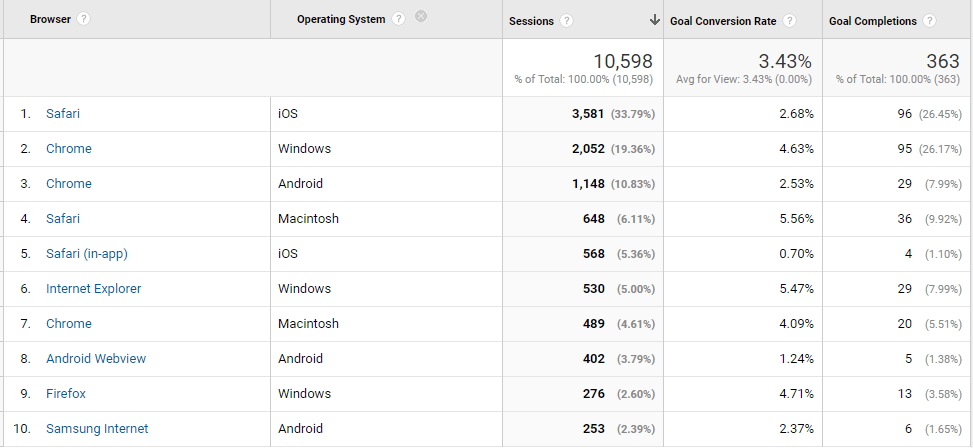Learn how to increase your conversion rates through simple but effective site audits using Fullstory, SEO tools, and more.
Have you ever felt overwhelmed by the number of issues on your site? Unsure what to address first? If you want to move quickly and boost conversions but have found yourself drowning in data, listen up.
Dana DiTomaso, President & Partner at Kick Point, recently offered up her expertise via a webinar titled Why Won't They Click This Button? Conversion Audits for Busy Marketers. The presentation was facilitated by Alexa Hubley, Customer Marketing Strategist at Unbounce, and was one of 14 webinar recordings viewed by over 8,000 marketers as part of Marketing Optimization Week.
Dana's presentation focused on how to bring together a site audit, analytics, and session replay and build a full picture of what's preventing conversions and causing user friction—and gain a list of specific action items you can implement right away.
Turn conversion audits into conversion fixes
Audits are great at helping you figure out everything that's wrong with a site. Unfortunately, when audits uncover a list of issues a mile long, busy marketers often simply don't have time to go through them one by one.
That's why it's important to quickly identify the most impactful fixes:
Your time shouldn't be spent on finding the problems. Your time should be spent on fixing them, so that you make more money.
Fixes are what pay the bills, not finding the fixes.
—Dana DiTomaso, Kick Point
Focus on what matters most
You can start getting to the fixes that really matter by asking the right questions:
What's the most broken?
What fix would have the most benefit?
Where are our best visitors (e.g., the ones who give you money) falling down? Where do they encounter problems?
Fullstory session replay helps you answer these questions and determine which issues are the most important—and on top of that, it helps guide you in solving them.
The conversion audit advantage of Fullstory
A traditional audit will outline your site's problems without giving you any additional insight into what's causing them. Fullstory, on the other hand, marries quantitative and qualitative data to identify problems and inspire the solutions. Most importantly, it helps Dana's team move fast:

When you use Fullstory session replay to investigate your user experience, you watch issues happen from the first-person perspective of customers who actually experienced them.
For example, you can watch sessions from paid search traffic and infer what is and what isn't working based on their actual behavior.
Or you can use Fullstory to analyze marketing funnels. Dana notes, "You can set up a funnel at any time, involving any steps, and unlike Google Analytics, you don’t need to wait for it to update."
Fullstory funnels show you the true picture of where your customers drop off so you can start addressing the biggest gaps. And because you don't have to worry about setting funnels up in advance, you can build one and get a visualization of results in a matter of minutes.

But how can Fullstory be used with conversion audits?
5 Fullstory conversion audit hacks
If you're ready for a specific action plan to put Fullstory to work for your site audits, begin with this 5-point conversion audit to do list:
Build segments.
Look for underperforming pages.
Make sure your paid search is paying off.
Deal with your rage.
Check the browser/OS combo.
Let's get started.

1. Build segments
A segment is any saved search in Fullstory. You can search for users who took step A, step B., etc. to build a funnel (as shown above or detailed in this blog post on the Fastest Funnels on the Web), and/or who meet any combination of demographic or device criteria.
Dana advises that you begin by creating segments for your high-value personas: the users who are (or could be) your best customers. This will help you aim the fire hose of session replay data at the most urgent blazes first.
→ Read more about finding Top Users in Fullstory.
Takeaway: What can you learn from your heaviest users? Search for their sessions and see how they engage with your website or app.
2. Look for underperforming pages
Next, Dana recommends running a Google Analytics report to get a list of the pages on your site with the lowest conversion rates.

While the Google Analytics report can focus your attention by showing you the pages where users struggle, only in watching real users interact with these pages can you see the specific reasons why they flail. That's where session replay steps in—you can observe directly what's causing the poor performance.
Takeaway: Use quantitative reports to identify opportunities and then use Fullstory to see what's working—or not.
3. Make sure your paid search is paying off
Fullstory makes it easy to search for and watch sessions of users who arrived to your site by paid search. As you watch users' step-by-step progress, you'll be able to see the reasons why they convert—or why they bounce. You can refine your search results to investigate a specific action or outcome, such as form abandonment.
For one of Dana's clients, session replay revealed that users were actually filling out the form, but then hitting a Download PDF button instead of Submit. These kind of nuanced behaviors around user experience are hard to understand via traditional analytics but easy to see in Fullstory.
Whatever is happening to prevent conversions, zooming in on user behaviors with replay will help you provide much-needed context around conversion numbers.
Takeaway: Search your sessions for those that arrive from paid channels. Make sure your most expensive visits are optimized so your investment doesn't go to waste.
4. Deal with your rage
One of most helpful ways to focus your attention in in Fullstory is by searching for Rage Clicks: the instances when a user clicks repeatedly and rapidly in frustration, which serves as a signal something isn't working like it should.
Consider this cringeworthy example of a customer having a disastrous time trying to select their seat at a client's concert hall site. They click everywhere as they try to select a seat, their frustration mounting, but nothing works.
As painful as this session replay is to watch, it helped Dana's team get to the bottom of the problem: a bug with the ticketing software that the concert hall used.
Takeaway: Sessions that include frustration signals are likely opportunities for quick wins. Search your Fullstory sessions for Rage Clicks.
5. Check the browser/OS combo
Another easy report to generate in Google Analytics is the conversion rate for each combination of browser and operating system.

From there, simply search in Fullstory by browser and OS to bring up session replays for your lowest-performing combinations.
As you watch these session replays, patterns will emerge that can help you explain what's causing the low conversions: e.g., perhaps the site loads slowly or the content is cut off. Whatever the case may be, you can begin formulating your plan to improve the experience for these users.
Takeaway: It's easy to forget that not everyone has the same experience of your site as you do, particularly when it comes to devices and operating systems. Use GA to see the most popular configurations and then turn to Fullstory to learn more about how those configurations are changing the user experience on your site.
5 bonus conversion audit hacks
Fullstory is a conversion audit Swiss Army knife, but what other tools should you keep in your bag of tricks? Dana shares her top five:
1. What happens when you call?
You can have a best-in-class online brand presence, but it will all be for naught if your customer service is poor. What happens when you pick up the phone and call your customer support line? What's the experience like? Are you treated in a way that aligns with your brand identity?
Dana shares an unfortunate example of a window manufacturing client whose installation team consistently received harsh reviews for their customer service, undermining the brand experience other stakeholders worked so diligently to create.
One call—that's all it might take to identify customer service problems that need your attention.
2. When did you last crawl your site?
A few regularly scheduled tune-ups will help make sure your site gives your customers a smooth ride. Dana recommends periodically using a site crawler tool such as DeepCrawl or Screaming Frog to check for broken links and other issues.
Also pay special attention to your key landing pages, and check that you don't have featured holiday or seasonal content that's no longer relevant.
3. Have you tried an ad blocker?
Many of your more computer-savvy customers probably have an ad blocker installed. Do you know what your site looks like with one enabled? Try using an ad blocker to see if your site still works correctly and your key marketing messages are still visible for these users.
4. Which results would you click?
The conversion funnel often starts on the search results page, before potential customers even get to your site. Optimize your presence on the SERP by writing helpful meta descriptions. Take advantage of Google's new maximum meta description length.

5. Whose content appears in the answer box?
Appearing at the top of the page, answer boxes are the Boardwalk and Park Place of Google search results real estate. If you can get Google to select your site's content for this space, you have an immediate advantage over your competitors, and the opportunity to begin converting customers before they even get to your site.

This takes some work, but to get started, check out Search Engine Land's three tips for answer boxes.
Put these hacks to work and boost conversions
Site audits are great but they're time-consuming and can leave you wondering where to begin. Use these tips to focus your efforts. Turn to Fullstory to prioritize fixes that will help deliver the most benefit to your bottom line. Think outside your site—make a phone call, scrutinize your site's appearance (or lack thereof) in the search results.
Don't get lost in the weeds of site audits. Focus your efforts, harvest the low-hanging fruit, and get more users to convert.
Thanks Dana and Kick Point for providing such excellent content around site audits—and supporting Fullstory!
Why Won't They Click This Button — Webinar recording
Presentation Outline
[8:00] Audits: the good, the bad, and the ugly
[8:42] How do you decide what's most crucial?
[9:22] Finding problems before they're big problems
[9:53] How we use Fullstory, wedding site example
[11:31] Using funnels in Fullstory
[13:06] Your Fullstory to-do list:
Building segments
Look for underperforming pages
AdWords + form abandons
Rage Clicks & Error Clicks
Check the browser/OS combo
[22:59] Your non-Fullstory to-do list:
What happens when you call?
When did you last crawl your site?
Try an ad blocker!
Which result would you click?
Could someone find everything they need just through answer boxes?
[28:59] Is your site too confusing? Why it's important to match your users' level of computer savviness
[31:14] Q&A
Why Won't They Click This Button — Conversion Audits for Busy Marketers




